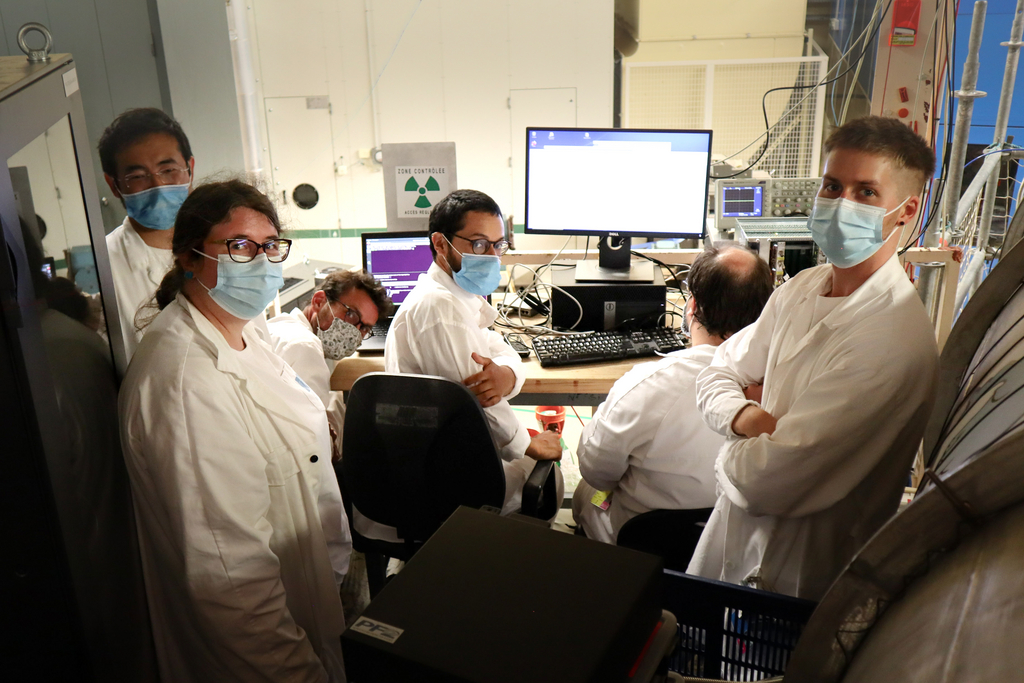Do Neutrons oscillate into a hidden world?
Today, physicists can describe our world with ever increasing precision: The Standard Model of particle physics successfully describes all observation concerning three out of four fundamental interactions - the electromagnetic, the weak and the strong interaction. Gravitation, the fourth known interaction, is fully explained by General Relativity. The application of General Relativity to the entire Universe, taking into account the Standard Model of Particle Physics, leads to the Standard Model of Cosmology, which explains many details of astronomical observations surprisingly well.
Nevertheless, there are numerous open questions from the theoretical side, and numerous observations lead to the conclusion that our current global picture of the Universe is incomplete. A prominent example is the observational evidence for Dark Matter, although no direct detection is confirmed yet.
To solve these questions, scientists work on extensions of the Standard Model of Particle Physics or General Relativity, on possible quantum theories of gravity, on alternative explanations of the observed phenomena, etc. Such theories naturally bring experimentalists onto the scene. They first try to re-interpret existing data in order to check whether the theory is already experimentally excluded. If this is not the case, specific experiments are designed to test the new theoretical ideas.
A long-standing idea is the so-called “hidden sectors” in physics. In such a scenario, all known particles and interactions of the Standard Model would have twin copies in a kind of “parallel Universe”. These twin copies could interact with our ordinary particles via the gravitational interaction and possibly exotic new interactions. Hence, the mystery of Dark Matter observed for example in the rotation curves of galaxies, could be solved.
In a recently published study in Physical Review Letters, a French-Swiss collaboration from University of Caen, University of Zurich/CH, University of Grenoble-Alpes, Sorbonne University of Paris, the Paul-Scherrer-Insitute in Villigen /CH and the ILL used the world’s most intense beam of ultra-cold neutrons at the PF2 instrument at ILL in order to test the existence of hidden sectors.To do so, the collaboration installed a six meter long ultra-cold neutron guide followed by their newly developed detector GADGET. “The key performance of the GADGET UCN detector is its high-rate capacity. PF2 was the optimal place to test our developments, and to perform this experiment.”, explains William Sáenz-Arévalo, one of the main authors of the study, and who also defended his PhD-thesis on this project.
[See his College 3 seminar - given on Dec 1st 2023 - at the bottom of this article]
The neutron guide was surrounded by a five-meter-long solenoid and some magnetic shielding. During the main measurements, the collaboration scanned the magnetic field strength and carefully checked for “missing neutron”-signals.
The hidden sector theory predicts that during their flight time in the instrument, neutrons could oscillate into their twin copies. The twins cannot be detected by GADGET. Hence, a drop in count rate would be observed. The probability of this effect should depend on the amplitude of the magnetic field induced by the solenoid.
Of course, the stability of the incoming neutron flux is of crucial importance. A drop in the incoming flux could mimic a false positive effect. The collaboration did not opt for the obvious solution to this problem, a beam monitor, because it would have reduced the high flux of PF2 considerably, and it could also induce new systematic effects. Instead, the collaboration applied a self-normalization algorithm. They divided each data cycle of 200s into sub-cycles applying three different magnetic field amplitudes. “By taking ratios of the neutron counts of different sub-cycles in a clever way, all linear instabilities cancel, and we can profit from the full beam intensity.”, explains Stephanie Roccia, who developed this method and convinced her colleagues of its validity.
“As a by-product, we learned a lot about the stability of the instrument PF2 on short- and medium time scales. This is very useful for our entire community”, states Tobias Jenke, instrument responsible of PF2.
After some months of careful data analysis, it turned out that the result was consistent with the prediction of standard physics. As a conclusion, the collaboration could exclude that neutrons oscillate into their hypothetical twin copies of a hidden world in the range of the probed magnetic field amplitudes. Although this study covers a considerable part of the parameter space for such theories, the existence of the hidden world is not yet completely excluded…
ILL Instrument: PF2, the Ultracold neutron facility
Reference: https://doi.org/10.1103/PhysRevLett.131.191801
Green Open Access: https://arxiv.org/abs/2303.10507
ILL Contact: Tobias Jenke
GADGET: Advancements in UCN Detection for Next-Generation Experiments
By William SAENZ-AREVALO - Laboratoire Physique Nucléaire et Hautes Energies
By William SAENZ-AREVALO - Laboratoire Physique Nucléaire et Hautes Energies
Since their initial production in 1969, Ultracold Neutrons (UCN) have played a crucial role in probing new physics through high-precision measurements. As experimental techniques for these investigations undergo upgrades, there is a continuous need for the development of state-of-the-art UCN detectors. This presentation highlights the innovative UCN gaseous detector, GADGET, specifically designed within the framework of the n2EDM project [1].
The talk will delve into the distinctive features of GADGET, shedding light on its design principles and operational characteristics. Notably, the discussion will emphasize recent breakthroughs in the field, particularly the results obtained from the neutron-to-hidden-neutron oscillation tests conducted during the monitoring of the UCN beam at the Institut Laue-Langevin (ILL) using GADGET [2]. These results not only showcase the detector's capabilities but also contribute to advancing our understanding of fundamental physics.
[1] Ayres, N.J., Ban, G., Bienstman, L. et al. The design of the n2EDM experiment. Eur. Phys. J. C 81, 512, 2021.
[2] G. Ban, J. Chen, T. Lefort, et al. Search for Neutron-to-Hidden-Neutron Oscillations in an Ultracold Neutron Beam. Phys. Rev. Lett. 131, 191801, 2023.



